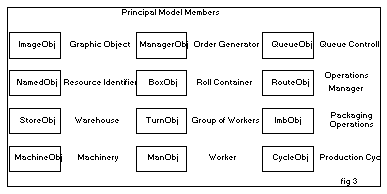Different types of objects were defined which correspond to the different parameters in the production process: machines, personnel, rollers, carts, orders, etc. (fig. 3).

Normally, each of these objects is connected dynamically to the others and thus it is possible to reassign personnel continuously to the different machines or carts and to transfer each roller from component to component.
Another important aspect of the model concerns transports: to correctly reconstruct the movements inside the plant, track objects were defined to join the different machines.
Thus, it was possible to consider the mutual interference between the different carts when they follow the same track in different directions. In practice, each track contains a route speed reduction factor that depends on the presence of other carts. All the information regarding the foreseen production cycle and the total quality level is contained within each roller (depending on whether or not skilled personnel are working on certain machines and on the type of route taken).
In this way it is possible to reproduce quality control operations on the product. If the outcome is negative, this generates a new lot that is identical to the present one and directs the relative product towards one of the degenerated cycles corresponding to the different routes utilized by the rejects in the plant.